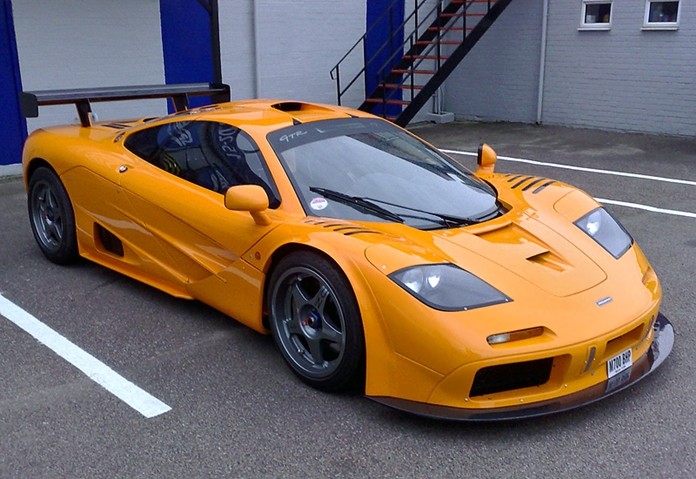
A McLaren F1 LM Specification is up for auction in the US with an expected bid of about $34m. Yes, 34 big ones.
The McLaren F1 is one of the rarest cars on the planet. And several features are supposed make this 1990s hypercar more precious than any other.
McLaren built just 64 road-going examples of the F1, only two of which were upgraded to Le Mans specification. Now one of those is up for auction at Monterey, California with the astronomical price tag.
It is claimed that the stratospheric price tag isn’t just due to its rarity.
Every F1 has an engine bay lined with pure gold. In total 16 grams were used for each vehicle.
The car up for auction has also had its V12 engine upgraded to produce 507 kW, up from 467 kW in standard form.
This power output puts it in rare air, even among modern supercars. Among the few to eclipse the 500 kW mark are the Ferrari 812 Superfast, Lamborghini Aventador S and McLaren 720S.
The car’s aero upgrade increased the down-force to cope with the extra grunt. There were also a number of turn-of-the-century modern conveniences added including upgraded air-conditioning and a radio with a CD player. (You’re kidding me. $34 million and you get a CD player!)
The car also has an odd seating layout with one centrally located driver’s seat and then two passenger seats set back from the driver’s chair.
With about 21,000km on the odometer, the McLaren is in great condition.
But $ 34 million?
Even if the McLaren fetches the anticipated $34m, it won’t come close to the most expensive car ever sold at auction.
That honor goes to a 1962 Ferrari 250 GTO that sold for $US 48.4 million at the same Monterey car auction last year.
And topping them all, a 1963 GTO sold privately in June last year for US$70 million making it the most expensive car purchase to date.
Short pockets and long arms
The $34 mill McLaren isn’t the only piece of precious metal going up for auction at Monterey. One of the four Aston Martin DB5s built for the James Bond films Goldfinger and Thunderball is up for auction with a price guide of US$4million-$6 million ($5.9m-$8.8m).
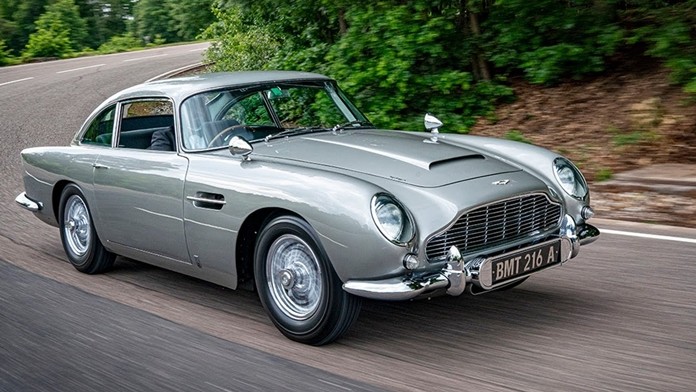
It comes with original Q specifications, including machine guns, tyre slashers, bulletproof rear screen, dash-mounted radar, rotating license plates and smoke screen dispenser. Lots of toys – if you have the money.
Local lad makes good
Breathtaking news that the young Thai/English driver Alexander Albon is to take over Pierre Gasly’s seat at Red Bull for the rest of the season. Unlike so many in F1 these days, Albon has been consistent and in the points.
Verstappen has won two of the last four races and Red Bull are genuinely in a fight with Ferrari for second place. They trail Ferrari by just 44 points. Gasly’s best finish this season was fourth at Silverstone. Crucially, he has not been able to play a part in a team role supporting Verstappen, their lead driver.
Albon, who was third in last year’s F2 championship, has 16 points. He produced outstanding performances to go from last to tenth at the Chinese Grand Prix and took sixth from 17th on the grid in treacherous wet conditions at the Hockenheimring. This was the first time he had driven an F1 car in the wet.
Red Bull might have promoted Daniil Kvyat to the seat but the Russian already raced for them in 2015-16 before he was similarly demoted to make room for Verstappen. The team knows what he can do so are now assessing Albon before making a decision on who will join Verstappen next year.
“Red Bull are in the unique position of having four talented Formula 1 drivers under contract who can be rotated between Aston Martin Red Bull Racing and Toro Rosso,” said a statement. “The team will use the next nine races to evaluate Alex’s performance in order to make an informed decision as to who will drive alongside Max in 2020.”
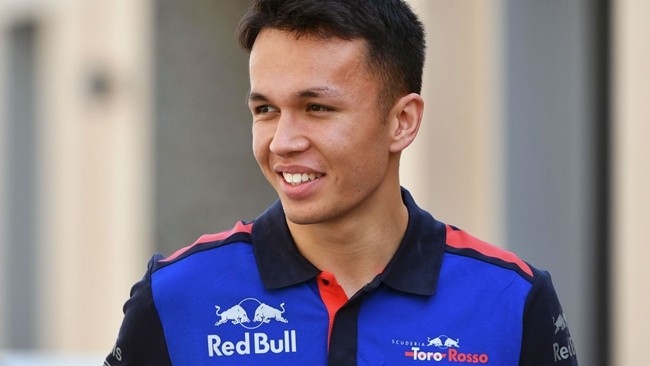
There is also the situation of money being brought to the team. It was reported last week that PTT were to sponsor Albon. Did the PTT money influence Albon’s elevation to the top team? We will never know, but we can guess.
The trouble with team mates
Over the years in F1 there have always been teams with two top drivers. It is almost impossible to take two highly competitive individuals, give them two identical cars, and expect that the two of them will work on an “after you.” “No, no, after you” basis. It takes supreme ability by the manager to keep the two cars from hitting each other. I watched a very interesting documentary on this subject, starting from pre-WW1 to around 10 years ago and looks at famous team tactics between equals. Prost and Senna shows a different side of the Brazilian.
The YouTube URL is https://www.youtube.com/watch?v=TWaPfSBuQOw
A two-wheeled nutter?
Have you heard of Francois Gissy? No? Well, he has done 333 km/h on a rocket propelled push bike.
The bike, designed by Gissy’s friend, Arnold Neracher, reached its top speed of 333 km/h in just 4.8 seconds and 250 meters.
“In the moment, it is scary, but as soon as you stop, you also realize how amazing that was,” Gissy said of the experience in an interview with the technology website Gizmag. But he said the wind is extremely powerful when travelling above 300 km/h. “I’m lucky my head is still bolted on the body!”
Gissy sits just above the rocket, which has three thrusters and is fastened to the frame.
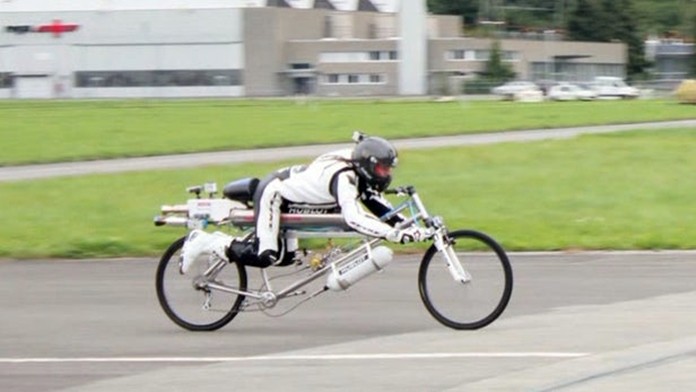
This was not his first time, Gissy’s previous speed record on a similar bike in 2013 was 263 km/h.
Exotic Thermo Engineering’s other inventions include a rocket-powered go-kart, a rocket car, and a jetpack called a “rocket belt.” (The latter must get the sphincter well and truly puckered!)
According to Guinness World Records, the fastest speed ever for a bicycle that wasn’t rocket powered was 268.831 km/h by Fred Rompelberg of the Netherlands, riding behind a wind-shield fitted Porsche in 1995 and assisted by the slipstream of the car.
The current unassisted bicycle speed record is 133.8 km/h — a record that a team in Toronto is trying to break.
Unfortunately, last year Gissy attempted to break his own record on a steam driven tricycle, crashed and was killed. A two wheeled dead nutter.
Zero to 100 clicks in 2.5 seconds – and it’s a motorcycle
According to Kawasaki, they have just unveiled a motorcycle that is so fast even daredevils are wondering if it is too powerful.
With a design inspired by Formula One motor racing cars and a supercharged engine that uses aerospace technology, the Kawasaki Ninja H2 covers from 0 to 100 km/h in less than 2.5 seconds.
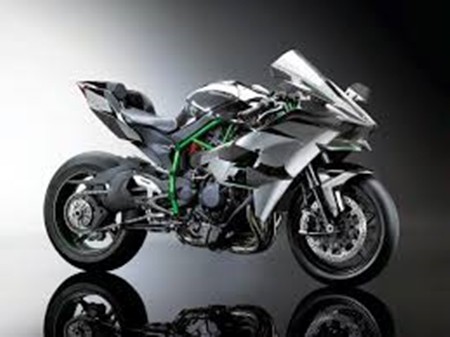
It can accelerate as quick as an F1 racing machine — if riders can hang on to it — because the supercharged engine has almost as much power as a Volkswagen Golf GTI hot hatch, but the Kawasaki Ninja H2 weighs barely one-fifth as much as the car.
The supercharger technology is so sophisticated it has been banned from international motorcycle racing since 1946, but has returned to a modern, road-going motorcycle in the search for more power from smaller engines.
The Ninja H2 is expected to comfortably overtake the previous titleholders of the world’s fastest bike including the Kawasaki Ninja ZX14-R from 2012, the Ducati Diavel from 2011, the Yamaha VMAX from 2010, and the Suzuki GSXR-1000 from 2006.
The official slogan “built beyond belief” may also go down in history as the most honest in advertising; even Kawasaki admits the Ninja H2 is “not for everyone, nor is it designed to be”.
When it comes to performance the Ninja H2 is so powerful Kawasaki has fitted a range of electronics that limit power to enable it to be ridden safely in wet weather or in slippery conditions, as well as a “launch control” mode to get the perfect start.
The brakes are bigger than those fitted to a mid-size V8 sedan.
Contrary to expectations, the motorcycle insurance industry in Australia is not up in arms over the supercharged superbike.
“There are already motorcycles on the road that can accelerate at racing car levels and many that can do more than 300 km/h,” said Swann Insurance research manager Robert McDonald.
“Generally most motorcycle owners only use these speed capabilities on organized track days. There are also many cars on the road currently that can do more than 300 km/h.”
The insurer said it was important to note the Kawasaki Ninja H2 had the latest available safety equipment, including intelligent anti-lock brakes, as standard.
“We don’t anticipate higher than normal claims rates with this motorcycle compared to other high-powered sports bikes on the road,” said McDonald. (McDonald has obviously not seen the way they ride motorcycles round here, but the purchase price will be beyond almost everyone in Thailand.)
Kawasaki Ninja H2
Engine: Supercharged 998 cc in-line four-cylinder
Power: 154.5 kW at 11,000 rpm (210 horsepower)
Torque: 140 Nm at 10,000 rpm
Transmission: Six-speed
Weight: 238 kg (ready to ride)
Brakes: 330 mm discs (front), 250 mm (rear)
0 to 100 km/h: Less than 2.5 seconds (estimated)
Top speed: 299 km/h (electronically limited, but racetrack H2R version can reach 340 km/h).




